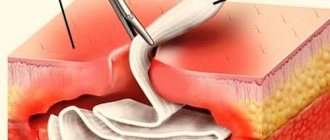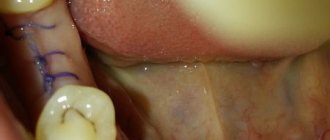Tooth extraction is a type of surgical intervention. The consequences of this operation may vary. Many people worry about the resulting wound. How long does it take for the affected area to heal, when will the bleeding stop and how often is ichor released after tooth extraction are some of the most exciting questions for patients. To prevent the development of complications, it is necessary to properly care for the resulting wound.
Sukrovitsa - f. Yellowish fluid that flows along with blood from the affected areas of the body, as well as bloody fluid that flows from abscesses and ulcers. Modern explanatory dictionary of the Russian language by Efremova
To prevent the development of complications after tooth extraction, it is necessary to properly care for the resulting wound.
Characteristic symptoms after tooth extraction (extraction)
During the process of tooth extraction, inevitable damage occurs to soft tissues, blood vessels, mucous membranes, nerve endings and other matters involved in holding the tooth. At the end of the operation, a natural inflammatory process develops, which is accompanied by various symptoms. Among which stand out:
- bleeding, the duration depends on various factors, can last from thirty minutes to three hours after tooth extraction;
- pain at the site of tooth extraction, which may be accompanied by pain in nearby teeth and even organs;
- swelling of the affected area;
- clearly defined redness of the mucous membrane at the site of the excluded tooth;
- possible increase in temperature;
- discomfort when moving the jaw.
The above signs are considered normal manifestations after tooth extraction. The inflammatory process decreases as the affected area is restored. As a rule, this takes from four to seven days . If an infection enters the body, the wound healing process is delayed and it is necessary to take medications.
In the place of the excluded tooth, a hole is formed that has sufficient depth, which is due to the long root system of the tooth. After bleeding stops from the site of tooth extraction, a blood clot forms, which promotes wound healing and prevents harmful bacteria from entering. If bleeding continues from the formed hole after tooth extraction for more than three hours, you must contact your doctor to take the required measures. This may include prescribing special medications, suturing the affected area, or using a hemostatic sponge.
Signs of inflammation
The inflammatory process in the socket occurs when a blood clot is damaged and the wound becomes infected. The following signs indicate its development:
- pain of varying intensity - aching, throbbing,
- fatigue and severe weakness,
- rise in temperature to subfebrile levels,
- unpleasant odor and taste in the mouth,
- pain when touched, contact with hot and cold,
- discharge of pus,
- difficulty chewing, swallowing, opening the mouth.
With alveolitis, the socket may become dry and a greenish or yellowish coating may form. If a blood clot falls out and pain occurs, do not put off visiting the dentist. It is easier to stop the inflammatory process at its beginning. The doctor will curettage the hole, treat the wound with an antiseptic solution, and prescribe antibacterial drugs.
Causes of ichor after tooth extraction
Associated factors influencing the duration of ichor discharge after tooth extraction:
- damage to blood vessels;
- inflammatory reaction in damaged tissues;
- hypertensive crisis;
- poor blood clotting indicators.
When a patient has hypertension, the risk of severe bleeding from the site of the extracted tooth increases. This is due to taking medications that lead to blood thinning. Experts recommend stopping taking such medications a couple of days before the planned surgery.
Also a dangerous factor is the presence of low blood clotting in the patient. In this case, it is recommended to take a course of sedatives to prevent surges in blood pressure.
When is bleeding dangerous?
The risk of massive bleeding during bone grafting is extremely low, since during the preoperative diagnosis the doctor excludes conditions against which this dangerous complication may develop. Therefore, you should not worry about bleeding during a sinus lift or other surgery. Thanks to several decades of experience, modern technologies and drugs, bone grafting is a quick and safe procedure that does not pose a threat to the patient’s life.
However, bleeding may occur later, at home, several days or even weeks after surgery. There are two main pathological conditions in which bleeding may occur after sinus lifting and bone grafting - vessel damage, hypertensive reaction, peri-implantitis and implant rejection.
Caring for the socket of an extracted tooth
After tooth extraction, to prevent the development of complications and reduce the secreted ichor, as well as to speed up the healing of the wound, it is necessary to properly care for the resulting hole. To do this, you should adhere to the following recommendations:
- Hold the tampon with the medicinal substance applied by the dentist for thirty minutes;
- If a blood clot forms in the socket, it is not recommended to rinse it, spit it out, or remove it by other methods during the day;
- Do not disturb the damaged area by palpating with your tongue or other means;
- Do not chew food with the place where the tooth was removed, and do not suck any drinks through a straw for 24 hours;
- Limit or completely eliminate heavy physical activity;
- Avoid visiting bathhouses, saunas, taking hot showers and prolonged exposure to sunlight for a day;
- The use of warming compresses in the area of tooth extraction is prohibited;
- For three hours after surgery, you must stop eating;
- To avoid the development of swelling and pain, it is necessary to eat only warm foods and drinks for several days;
- Eliminate hot, spicy additives, as well as foods with sour and strong tastes for a couple of days. Such dishes can contribute to the opening of re-bleeding;
- If food particles get into the hole with a clot, you must rinse your mouth until they are completely removed. In this case, it is strictly forbidden to use a toothpick, fingers or other methods to clean the socket, since it is possible to disrupt the formed blood clot;
- Eliminate the use of alcohol and tobacco products for a period of three to seven days;
- After 24 hours after the operation, it is necessary to rinse the mouth with a soda solution or special antiseptic agents;
- When cleaning tooth enamel, it is necessary to perform this operation extremely carefully in the area of the extracted tooth;
What can and cannot be done after tooth extraction?
In case of individual intolerance to pain after tooth extraction, it is permissible to use medications against pain, which belong to the group of non-steroidal anti-inflammatory drugs. When performing surgery against the background of infectious diseases in the oral cavity, for further recovery it is necessary to take a course of antibiotics.
After the removal of a wisdom tooth, you must adhere to the same recommendations, the only difference is that the symptoms are more severe.
Types of violation
Dentists distinguish several types of postoperative bleeding:
- Early or primary. The blood does not stop flowing for a long time immediately after the unit is pulled out. The dentist has to take various measures to stop it.
- Later or secondary. The bleeding quickly stopped at the clinic, but reappeared at home. In such a situation, many people are lost and do not know what to do. There is only one rule - if a negative symptom persists for more than an hour, you should immediately visit a dental surgeon.
Generally speaking, the appearance of blood at the site of the hole should be taken calmly. During extraction, soft tissues and blood vessels are damaged. Therefore, there is nothing strange about bleeding. You need to look at its dynamics. Every day a person’s condition should improve, as should the appearance of the hole in the oral cavity. If this does not happen, then there is some problem. It needs to be identified and eliminated.
Ways to stop ichor after tooth extraction
After tooth extraction, the dentist carries out a number of measures to stop bleeding:
- installation of a tampon impregnated with special medicinal substances;
- application of a hemostatic sponge;
- prescribing medications for better blood clotting;
- suturing the damaged area.
During normal tooth extraction, to stop bleeding, it is enough to use a tampon, which is held pressed for thirty minutes. If complications arise to stop bleeding, more radical measures are used in the form of suturing; this technique is used in case of damage to the artery. When small vessels are damaged, coagulation (cauterization of ruptured vessels) is most often used. After removing a wisdom tooth or several teeth located nearby, additional sutures are applied to prevent the development of complications.
If it is impossible to quickly determine the cause of bleeding, injections with substances are administered to stop the bleeding. Two methods are used for this:
- Intramuscular injection of Vikasol solution one percent;
- Intravenous injection of a solution of the following components: ten percent calcium chloride solution, calcium gluconate.
If bleeding occurs at home, you need to prepare a small tampon or sterile bandage. Place on the damaged area, after thoroughly washing your hands, and eat for a period of forty minutes. If this method does not help stop the ichor, it is necessary to prepare a new tampon, which must be moistened with a three percent solution of hydrogen peroxide. This solution has a clotting effect on the blood. Apply the tampon for five to ten minutes.
If the bleeding cannot be stopped, you should consult a doctor as soon as possible.
Implant rejection
The materials from which implants are made in modern dentistry are, in the vast majority of cases, normally accepted by the body's defense systems. Therefore, the risk of implant rejection after sinus lifting and bone grafting is extremely low. However, implant rejection sometimes occurs in patients and without timely diagnosis and treatment can lead to serious health consequences.
The most unpleasant thing is that when an implant is rejected there is never a violent pain reaction or severe bleeding, but periodically minor bleeding occurs that quickly passes. The main bad sign is the unpleasant odor that accompanies bleeding from the area of previous surgery.
There are a number of pathological conditions in which the risk of rejection increases significantly. These include congenital and acquired immunodeficiency, autoimmune diseases, diseases of the endocrine system. Bleeding is one of the symptoms of implant rejection, and if the rejection process begins in the first days after the intervention, the bleeding can be quite intense. Also, with rejection, symptoms characteristic of inflammation progress (pain, swelling, redness of tissue, fever). Normally, signs of inflammation should subside 7-10 days after the intervention. However, if bleeding, pain and other unpleasant sensations persist for longer, then you must be examined by a dentist to rule out incipient implant rejection. Treatment of this rare complication is carried out surgically against the background of antibacterial and anti-inflammatory therapy.
How long does it take for a dry socket to heal?
Many people are interested in the question of how long it takes for a dry socket to heal. In the absence of complications, the wound heals in 5 - 7 days, and within a month the hole is filled with epithelial tissue. If you have dry socket, the healing process may take longer than two weeks (with proper treatment, of course). As already mentioned, extensive inflammation may occur and even require surgical hospitalization of the patient: in this case, the healing of the dry socket may be very delayed.
Precautions before surgery
To prevent bleeding from overshadowing your treatment, diagnosis is one of the key stages in preparation for surgery. During a comprehensive examination of the patient, the doctor must identify contraindications to bone grafting. If the patient has any contraindication to surgery, then it is unsafe to perform it and the doctor should advise another option for restoring the dentition. One of the absolute contraindications to sinus lifting and other types of osteoplasty is coagulopathy. This group of pathological conditions is characterized by serious disturbances in the blood coagulation system, which normally should ensure timely stopping of non-massive bleeding.
Coagulopathies can be either congenital or acquired, but all coagulopathies are dangerous to human life and health when even minimal surgical intervention is performed. At the diagnostic stage, special studies are carried out to exclude hemophilia, von Willebrand disease and other coagulopathies. Before the operation, the patient undergoes a number of instrumental and laboratory research methods, which include a coagulogram and prothrombin study. They also pay attention to the level of platelets in a general clinical blood test. Without these studies, the doctor cannot be sure of the safety and effectiveness of the upcoming intervention. Therefore, careful preoperative diagnosis is the main measure to prevent bleeding after sinus lifting and bone grafting.
At our clinic, additional diagnostic tests can be performed on site; there is no need to travel anywhere.










